In comment letters, prominent accounting firms highlighted the costs and practical challenges for foreign private issuers (FPIs) if the Securities and Exchange Commission (SEC) required them to file their financial statements that comply with U.S. GAAP.
Their letters come as the SEC is mulling changes to the definition of FPI as the global regulatory and business environment has changed significantly since the agency last reviewed the foreign company framework in 2008.
FPIs are foreign companies that list shares on U.S. stock exchanges, and the SEC has historically provided regulatory accommodations that provide full or partial relief not available to domestic companies. For example, FPIs do not need to file quarterly reports or proxy statements, are not subject to Regulation Fair Disclosure, and furnish current reports on Form 6-K, rather than filing the more prescriptive Form 8-K.
In accounting, FPIs can file financial statements following International Financial Reporting Standards (IFRS) without reconciling to U.S. GAAP.
“Converting to US GAAP would likely require an issuer that loses FPI status to make substantial internal changes, including to personnel and systems, training and education (particularly in markets where the supply of suitably qualified US GAAP expertise is limited), and amendments to agreements, such as those that include debt covenants,” Ernst and Young LLP wrote in response to the commission’s preliminary rulemaking document or a concept release issued in June 2025 to solicit the public’s comments on potential changes.
“Therefore, we also expect many issuers to seek external support from firms offering US GAAP expertise, and audit fees would likely increase significantly in the year of conversion, with more moderate increases in subsequent years,” EY wrote.
Besides EY, other accounting firms that wrote comment letters are Deloitte & Touche LLP, KPMG LLP, BDO USA, P.C., Grant Thornton LLP, as well as the Center for Audit Quality (CAQ), an affiliate of the AICPA which represents accounting firms that audit public companies. And they made similar arguments in their letters. PricewaterhouseCoopers LLP did not write a comment letter.
KPMG further explained that preparing in accordance with U.S. GAAP requires companies to fully understand the reporting framework, which extends beyond executive leadership responsible for signing certifications under the Sarbanes-Oxley Act of 2002. This comprehensive understanding must include all personnel involved at the transactional and process level.
“Proficiency in US GAAP is essential for all individuals accountable for overseeing processes and systems that support effective internal control over financial reporting,” (ICFR), KPMG wrote.
Because it has been almost two decades since the SEC eliminated the reconciliation requirement, many FPIs accounting and financial reporting departments may not have U.S. GAAP knowledge.
“Further, adding US GAAP reporting requirements would not replace the need for most affected entities to maintain accounting records under IFRS-IASB,” KPMG explained. “Rather, it would likely create an additional accounting framework for these entities to manage.” IASB is International Accounting Standards Board.
In addition to IFRS or versions of IFRS that have been adopted locally, home jurisdictions may also require the use of local GAAP for tax purposes, the Big Four firm said. For these companies, the introduction of U.S. GAAP would result in a third set of reporting requirements.
A switch to U.S. GAAP would also pose challenges for auditors who follow International Standards on Audits (ISA) in local jurisdictions.
“Integrated audits of IFRS-IASB financial statements under PCAOB auditing standards are typically conducted concurrently with audits subject to ISA,” KPMG wrote. The Public Company Accounting Oversight Board (PCAOB) writes auditing standards for public companies in the U.S.
“However, if an integrated audit of US GAAP financial statements is also needed, there may be few efficiencies to gain,” KPMG said. “Audits of two distinct sets of financial statements, under different accounting frameworks, with separate disclosures that require independently designed internal controls will need to be conducted separately, often in tight timeframes.”
Further, FPIs file financial statements in the currency determined by management as the entity’s reporting currency. Issuers that are not FPIs must report their financial statements in U.S. dollars. A conversion to U.S. dollars “would add an additional layer of complexity and ICFR to the preparation of the US GAAP financial statements for affected FPIs,” the firm said.
Consequently, the CAQ encouraged the SEC to evaluate all alternatives. But if the commission decides to move forward with changes to the FPI definition that result in certain companies losing FPI status, the CAQ said the commission should provide affected companies with adequate time to build the infrastructure to effectively report as a domestic filer.
In the meantime, 77 letters were submitted in response to the concept release, with the vast majority asking the SEC either not to change the FPI definition or to move with careful deliberation. Law firms, exchanges, trade associations, and a few foreign companies wrote the letters.
The Business Law Section of the American Bar Association (ABA) urged the SEC to maintain the current FPI definition because the existing regime continues to function precisely as intended in achieving the necessary and appropriate balancing of interests.
“The burden of requiring every foreign issuer to conduct an FPI status reassessment, and the potential consequences of a loss of FPI eligibility, appears to us to be entirely unnecessary and unjustified,” the ABA wrote. “Further, in the particular circumstances of each foreign issuer, the transition from eligibility under the current definition to ineligibility under an amended definition would not necessarily be reflective of an intended change in policy or achieve an intended U.S. investor protection enhancement, but rather be the happenstance result of technical differences between the old and new tests.”
However, some support changing the qualifications for FPI status with a caveat. Treasurers, comptrollers, or auditors of about 20 states said the SEC should not confer FPI status to any issuer based in a country designated by the U.S. government as a foreign adversary, including China.
The SEC staff, who studied Form 20-F filings by FPIs from fiscal 2003 to 2023, found that today almost 55% of FPIs have their stocks traded almost exclusively in U.S. markets. In 2023 the largest jurisdiction measured by issuer incorporation is the Cayman Islands, and the largest jurisdiction by issuer headquarters is China. But this was not the case 20 years ago. Canada, which has a more robust regulatory regime, had the largest percentage of FPIs.
“FPI status was formed with the understanding that issuers qualifying for FPI status would still be subject to ‘meaningful disclosure and other regulatory requirements in their home country jurisdictions,’” they wrote. “But this shift in the types of filers using FPI status raises concerns that U.S. investors are not being protected. There are significant risks for U.S. investors in China-based companies, including Chinese companies’ roles in furthering the Chinese Communist Party’s ‘military-civil fusion’ strategy and the risks that China-based issuers will violate the disclosure, auditing, or other antifraud provisions of the Securities Exchange Act due to the Chinese government’s actions to prevent transparency.”
Take your tax and accounting research to the next level with Checkpoint Edge and CoCounsel. Get instant access to AI-assisted research, expert-approved answers, and cutting-edge tools like Advisory Maps and State Charts. Try it today and transform the way you work! Subscribe now and discover a smarter way to find answers.












